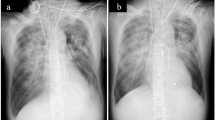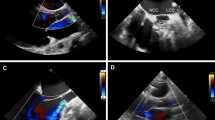Abstract
Despite left ventricular assist device (LVAD) therapy becoming established for end-stage heart failure (HF), complications remain. Thromboembolic complications are rare with the newest iteration of LVADs. We managed a case of a continuous-flow LVAD-related thromboembolic event that presented as an acute myocardial infarction. A 64-year-old male who underwent Heartmate III® LVAD implantation had crushing substernal chest pain and ventricular tachycardia with acute anterolateral myocardial infarction on electrocardiogram on post-operative day 9. Echocardiography showed closed aortic valve and mild aortic regurgitation, but CT angiography showed thrombus within the left coronary cusp despite full anticoagulation. Continuous suction of blood from the left ventricle despite pulsatile flow into the ascending aorta resulted in a minimally opening aortic valve and stagnation of blood leading to thrombosis on the coronary cusp. Apart from post-operative ventricular tachycardia and right ventricular failure, he had adequate body size (body surface area 2.13 m2) and no post-operative or coagulopathy which could predispose him to thrombosis. Coronary angiography revealed stable severe three-vessel disease and thrombus in left main and proximal circumflex artery, and he had aspiration thrombectomy, and international normalized ratio target was increased to 3–3.5 with aspirin 325 mg daily. He survived to discharge but died 60 days after LVAD implant with multiple low flow alarms, and cardiac arrest. We review the literature and propose a management algorithm for patients with impaired AV opening and aortic root thrombosis.



Similar content being viewed by others
References
Kirklin JK, Naftel DC, Pagani FD, Kormos RL, Stevenson LW, Blume ED, et al. Seventh INTERMACS annual report: 15,000 patients and counting. J Heart Lung Transplant. 2015;34:1495–504.
Starling RC, Moazami N, Silvestry SC, Ewald G, Rogers JG, Milano CA, et al. Unexpected abrupt increase in left ventricular assist device thrombosis. N Engl J Med. 2014;370:33–40.
Mehra MR, Uriel N, Naka Y, Cleveland JC Jr, Yuzefpolskaya M, Salerno CT, et al. A fully magnetically levitated left ventricular assist device—final report. N Engl J Med. 2019;380:1618–27.
Nakajima S, Seguchi O, Murata Y, Fujita T, Hata H, Yamane T, et al. Left coronary artery occlusion caused by a large thrombus on the left coronary cusp in a patient with a continuous-flow ventricular assist device. J Artif Organs. 2014;17:197–201.
Fried J, Han J, Naka Y, Jorde UP, Uriel N. Myocardial infarction after left ventricular assist device implantation: clinical course, role of aortic root thrombus, and outcomes. J Heart Lung Transplant. 2014;33:112–5.
Shah S, Mehra MR, Couper GS, Desai AS. Continuous flow left ventricular assist device related aortic root thrombosis complicated by left main coronary artery occlusion. J Heart Lung Transplant. 2014;33:119–20.
Tanna MS, Reyentovich A, Balsam LB, Dodson JA, Vainrib AF, Benenstein RJ, et al. Aortic root thrombus complicated by left main coronary artery occlusion visualized by 3D echocardiography in a patient with continuous-flow left ventricular assist device. Echocardiography. 2017;34:306–10.
Dickerman RD, Schaller F, McConathy WJ. Left ventricular wall thickening does occur in elite power athletes with or without anabolic steroid use. Cardiology. 1998;90:145–8.
Rajagopalan N, Wilson RE. ST-segment elevation myocardial infarction in patient with left ventricular assist device. VAD J. 2015. https://doi.org/10.13023/VAD.2015.07.
Demirozu ZT, Frazier OH. Aortic valve noncoronary cusp thrombosis after implantation of a nonpulsatile, continuous-flow pump. Tex Heart Inst J. 2012;39:618–20.
Freed BH, Jeevanandam V, Jolly N. Aortic root and valve thrombosis after implantation of a left ventricular assist device. J Invasive Cardiol. 2011;23:E63–5.
Funding
None.
Author information
Authors and Affiliations
Corresponding author
Ethics declarations
Conflict of interest
The authors declare that they have no conflict of interest.
Additional information
Publisher's Note
Springer Nature remains neutral with regard to jurisdictional claims in published maps and institutional affiliations.
Rights and permissions
About this article
Cite this article
Ilonze, O.J., Torabi, A., Guglin, M. et al. Aortic root thrombosis leading to STEMI in a Heartmate 3 patient. J Artif Organs 26, 73–78 (2023). https://doi.org/10.1007/s10047-022-01339-y
Received:
Accepted:
Published:
Issue Date:
DOI: https://doi.org/10.1007/s10047-022-01339-y




